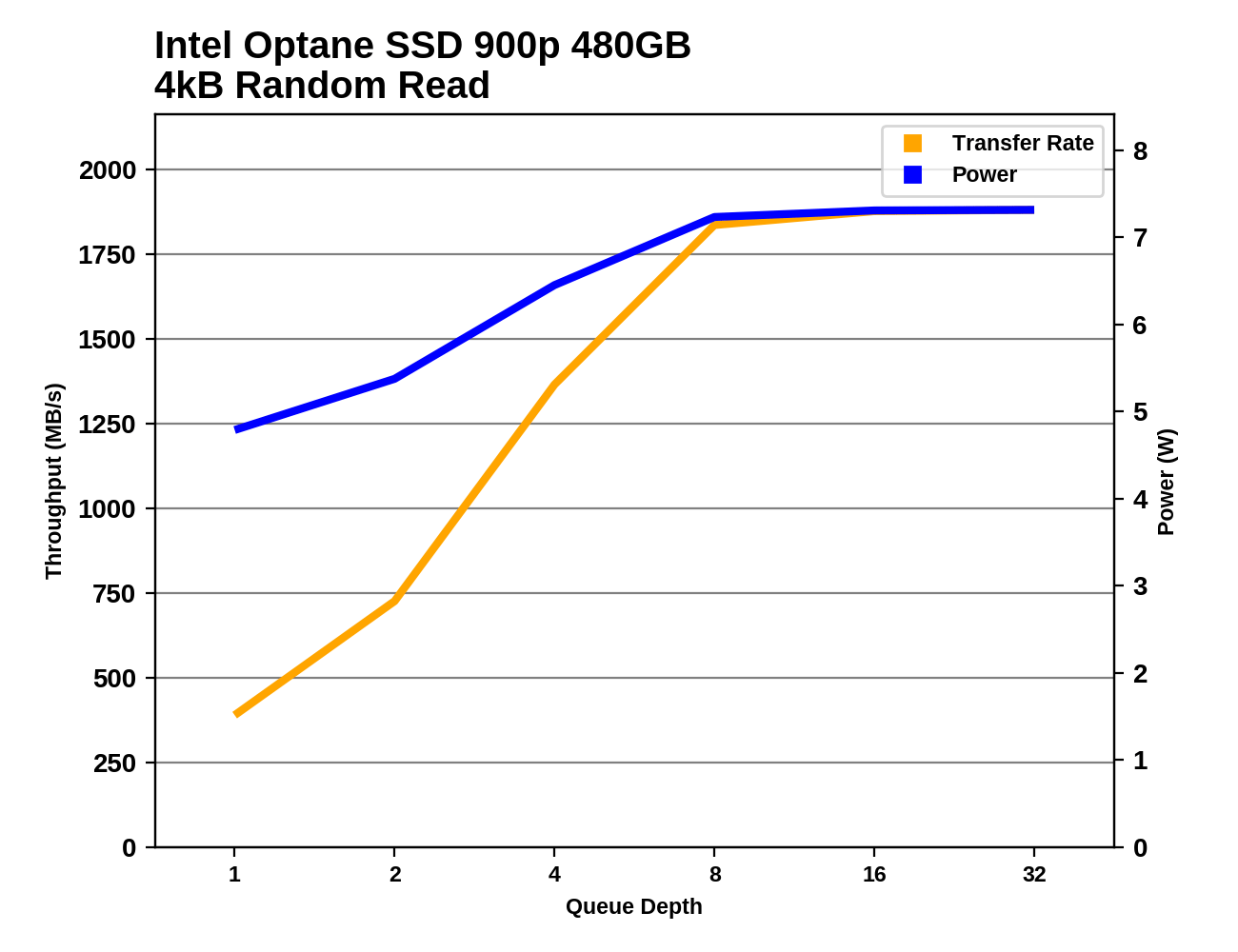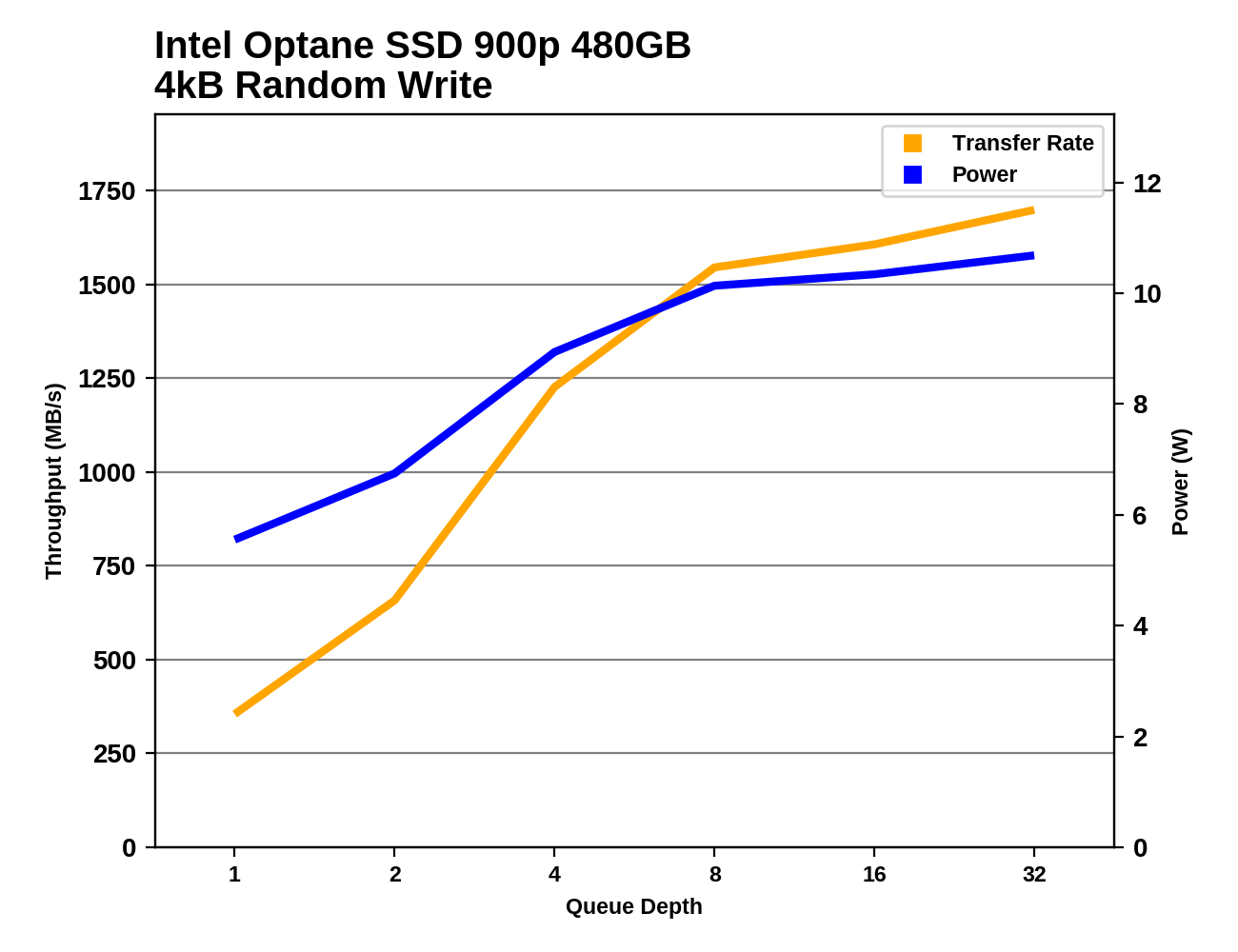The Intel Optane SSD 900p 480GB Review: Diving Deeper Into 3D XPoint
by Billy Tallis on December 15, 2017 12:15 PM ESTRandom Read Performance
Our first test of random read performance uses very short bursts of operations issued one at a time with no queuing. The drives are given enough idle time between bursts to yield an overall duty cycle of 20%, so thermal throttling is impossible. Each burst consists of a total of 32MB of 4kB random reads, from a 16GB span of the disk. The total data read is 1GB.

Random reads at queue depth 1 are where Intel's Optane products shine. Compared to the fastest NVMe SSDs using MLC NAND flash, the Optane SSDs aren't quite an order of magnitude faster, but only because the latency of the NVMe protocol over PCIe becomes the bottleneck. Intel's tiny Optane Memory M.2 cache drive is slightly faster in this one benchmark, but the difference hardly matters.
Our sustained random read performance is similar to the random read test from our 2015 test suite: queue depths from 1 to 32 are tested, and the average performance and power efficiency across QD1, QD2 and QD4 are reported as the primary scores. Each queue depth is tested for one minute or 32GB of data transferred, whichever is shorter. After each queue depth is tested, the drive is given up to one minute to cool off so that the higher queue depths are unlikely to be affected by accumulated heat build-up. The individual read operations are again 4kB, and cover a 64GB span of the drive.

Adding some higher queue depths to the average shows a small speed advantage for the 480GB Optane SSD over the 280GB model, and the Optane Memory M.2 starting to fall behind the larger Optane SSDs. The NAND flash-based SSDs also pick up speed as queue depths grow, but they need to go far beyond QD4 to catch up.

Given how thoroughly the Optane SSDs have shattered the record for random read performance, it's not too surprising to see them at the top of the charts for power efficiency when performing random reads. The 480GB Optane SSD is a bit less efficient than the smaller model because it has to power significantly more 3D XPoint memory chips with only a small performance boost to show for it. Compared to the flash-based SSDs, the Optane SSDs are only about 2.5 times more efficient, despite being about 7 times faster. The performance doesn't come for free.
 |
|||||||||
At low queue depths the two Optane SSDs offer nearly the same random read performance. When they both reach saturation at QD8, the 480GB model has slightly higher performance, and is drawing about 0.85W more power—a 13% power increase for a 7% performance boost.
Random Write Performance
Our test of random write burst performance is structured similarly to the random read burst test, but each burst is only 4MB and the total test length is 128MB. The 4kB random write operations are distributed over a 16GB span of the drive, and the operations are issued one at a time with no queuing.

The random write performance at queue depth 1 of the Optane SSDs is great, but not record-setting. Flash-based SSDs can cache write operations in their DRAM and report the command as complete before the data has actually made it to the flash memory. This means that for most flash-based SSDs the burst random write speed is more of a controller benchmark than a test of the storage itself. The Optane SSDs don't have large DRAM caches on the drive and are actually writing to the 3D XPoint memory almost as quickly as the Intel SSD 750 can stash the writes in its DRAM.
As with the sustained random read test, our sustained 4kB random write test runs for up to one minute or 32GB per queue depth, covering a 64GB span of the drive and giving the drive up to 1 minute of idle time between queue depths to allow for write caches to be flushed and for the drive to cool down.

With larger queue depths and test durations long enough to defeat any DRAM-based write caching and many SLC write caches, the Optane SSDs rise to the top. With this second round of testing, the 280GB Optane SSD performed slightly worse than the first run, but it's still essentially tied with the fastest flash-based SSDs. The 480GB model is a tiny bit faster than even the previous record from the 280GB model, putting it about 8% faster than the Samsung 960 PRO.

Without a huge performance lead, the high power consumption of the Optane SSDs takes a toll on their efficiency scores for random writes. They are ahead of early NVMe SSDs and on par with the fastest SATA SSDs, but the best current flash-based NVMe SSDs are substantially more efficient. The Toshiba XG5 prioritized efficiency over peak performance and ends up offering more than twice the power efficiency of the Optane SSDs, while the Samsung 960 EVO has a mere 77% efficiency advantage at essentially the same level of performance.
 |
|||||||||
As with random reads, the performance and power consumption gap between the two Optane SSD 900p capacities widens at higher queue depths. With power consumption starting at 5W and climbing to over 10W for the larger model, the Optane SSDs are in a completely different league from M.2 NVMe SSDs, which mostly top out around 4.5W.










69 Comments
View All Comments
eddman - Sunday, December 17, 2017 - link
That graph explains the situation perfectly. Even if the media's latency was somehow magically reduced to zero, the total storage latency would still be only about 6 times better.It's all pointless though; ddriver's personal hatred towards intel and "the corporations" prevents him from thinking differently. As soon as he finds a number that is different from what was mentioned in the promotional materials, the first thing he does is to start shouting "liar, liar".
P.S. I have zero love for corporations and can't stand when one takes advantage of the users. What I also can't stand is a person spreading unsubstantiated claims and spamming a technology website's comment section to offload his hate in order to feel better.
tuxRoller - Friday, December 15, 2017 - link
Also z nand appears to be mlc cells operating in SLC mode, and that's still slower than first gen xpoint.hescominsoon - Friday, December 15, 2017 - link
Intel has walked back the 100x bs claims. Also notice how micro(their partner in this venture) has NOT released their side of this product?https://semiaccurate.com/?s=optane
tuxRoller - Saturday, December 16, 2017 - link
They walked them back? Maybe for these nvme products, though I've not seen anything about that. The real test is how well they'll do as direct addressed memory when used in the DIMM configuration.Reflex - Friday, December 15, 2017 - link
SLC has no significant advantages over Optane. Optane is nearly across the board a better performer, often by a significant margin, than any commercial NAND technology. The two drawbacks that are important right now are power consumption and cost (these are also drawbacks of SLC for the record)The complaints about Intel's 'hype' are misconstrued. There is a huge difference between discussing what a technology is capable of, and what individual products derived from that technology can deliver. That some people had reading comprehension problems is not Intel's problem, they are delivering what they promised, and as the rest of the supporting infrastructure improves over time we know based on their initial statements that Optane/PCM can scale to match it.
CheapSushi - Friday, December 15, 2017 - link
The industry is trying. It's called Z-NAND.ddriver - Friday, December 15, 2017 - link
Which is MLC...Samsung realized nobody is catching up in the nand market and decided to push consumer, high end and mainstream enterprise a notch down to TLC.
So now that MLC is only a "high end enterprise" thing in their portfolio, they decided to pimp it up with a new moniker - z-nand. Alas, it is just good old MLC with a barely incremental controller. And claim that it has anything to do with SLC performance - which it does as much as an a race horse harness makes an old donkey faster.
They REALLY aren't trying.
CheapSushi - Saturday, December 16, 2017 - link
It's MLC & TLC 3D NAND treated exactly like SLC (1 bit per cell) with a better controller and special sauce, effectively making it as if it was SLC in the first place and a better SLC driver than previous SLC drives that came out. So what is the issue? It's not a completely separate NAND production line?ddriver - Saturday, December 16, 2017 - link
Do you realize parroting nonsense you are clearly completely ignorant of doesn't win you bonus points?There is no such thing, you have to compromise one for the sake of the other. It is just more mature and a tiny bit better than previous gen MLC, but it is not even half of what can be squeezed of contemporary SLC.
"Special sauce"? It is sad to see average Joe hans't moved up a bit since the middle ages.
drajitshnew - Saturday, December 16, 2017 - link
No "ryzen" in opposition to their "core". The flash industry is in a race to see who can make the CHEAPEST PoS